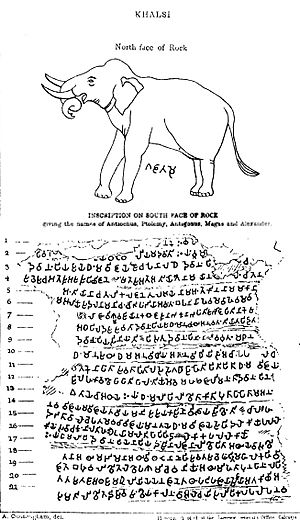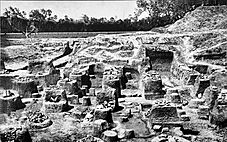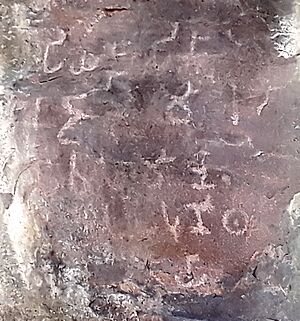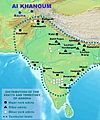Ashoka the Great facts for kids
Quick facts for kids Ashoka the Great |
|
|---|---|
| Priyadarśin Devanapriya Chakravartin | |
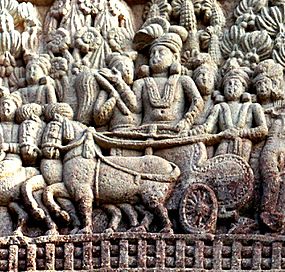
|
|
| 3rd Mauryan Emperor | |
| Reign | c. 268 – c. 232 BCE |
| Coronation | 268 BCE |
| Predecessor | Bindusara |
| Successor | Dasharatha |
| Born | c. 304 BCE Pataliputra, Mauryan Empire (adjacent to present-day Patna, Bihar, India) |
| Died | 232 BCE (aged c. 71 – 72) Pataliputra (modern-day Patna), Bihar, India |
| Spouse |
|
| Issue |
|
| Dynasty | Maurya |
| Father | Bindusara |
| Mother | Subhadrangi or Dharma |
| Religion | Buddhism |
Ashoka (or Asoka) was a great emperor of India. He ruled the Maurya Empire from about 268 BCE to 232 BCE. His full name, Priyadarśin Devanapriya Chakravartin, means "He who is loved by the Gods and who is friendly to everyone."
Ashoka is often seen as one of India's most important emperors. He led many military victories and ruled over a large part of what is now India. One of his most famous battles was against the kingdom of Kalinga. This war was very brutal, with over 200,000 people dying or being captured.
After this terrible victory, Ashoka felt very sad and regretful. He decided to change his ways and became a Buddhist. He chose to lead with peace instead of war. To show his new path, he built hospitals for both animals and people. He also created shaded resting areas along roads for travelers and dug wells in villages. We know about these actions from writings found on rocks and pillars from his time.
Contents
Early Life and Family
We don't have many details about Ashoka's early life from his own writings. Most of what we know comes from stories written hundreds of years later. These stories sometimes include magical details, but they also give us some ideas about his life.
When Ashoka Lived
The exact date of Ashoka's birth is not known for sure. However, we know he lived in the 3rd century BCE. His writings mention other rulers from that time whose dates are known. This helps historians figure out that he was likely born around 304 BCE.
His Family
Ashoka's own writings don't talk about his family history. But other old texts say his father was Emperor Bindusara. His grandfather was Chandragupta Maurya, who started the Maurya Empire.
Stories say that Ashoka's mother was the daughter of a wise man from Champa. She was believed to be destined to marry a king. She joined Bindusara's royal family and became his main queen. Some stories call her Subhadrangi or Dharma.
Ashoka as a Prince
Some legends say that Ashoka's father, Bindusara, didn't like Ashoka's looks. However, Bindusara still gave Ashoka important jobs. This suggests that Ashoka had other good qualities that impressed his father.
Dealing with a Rebellion
According to one story, Prince Ashoka was sent to stop a rebellion in the city of Taxila (now in Pakistan). This city was very important for trade and politics. The story says that when Ashoka arrived, the people of Taxila welcomed him. They told him they were rebelling only against bad ministers, not against the king.
Another story says that Ashoka was sent to govern Ujjain, an important city in central India. This is supported by an inscription found in central India, which mentions Ashoka visiting the area as a prince.
While in Ujjain, Ashoka met a woman named Devi. She was the daughter of a merchant. Some Buddhist stories say she was a Buddhist herself. Devi gave birth to Ashoka's son, Mahinda, and his daughter, Sanghamitta. Both Mahinda and Sanghamitta later became important Buddhist figures.
Becoming Emperor
Stories suggest that Ashoka was not the first choice to be emperor. There might have been a fight for the throne among Bindusara's sons. Some texts say Ashoka became emperor about 268 BCE. One story says he officially became king four years after taking control. This gap might mean he spent those years fighting to secure his position.
Before His Change
Before Ashoka became a Buddhist, many stories describe him as a very strong and sometimes violent ruler. One text even calls him "Chandashoka," meaning "Ashoka the fierce," because of his actions.
The Kalinga War and His Conversion
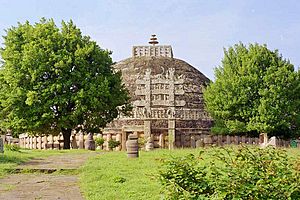
Ashoka's own writings tell us that he conquered the Kalinga region during his eighth year as emperor. This war was incredibly destructive. His writings say that 100,000 people and animals were killed, and many more died later. About 150,000 people were taken away as captives.
Ashoka was deeply shocked and saddened by all this suffering. He felt great regret for the violence he had caused. This experience changed him completely. After the Kalinga War, he turned towards Buddhism. He decided to dedicate himself to peace and to spreading dharma, which means righteous conduct or moral law. He declared that he now found war and its suffering painful and wrong.
Ashoka's Reign After Becoming a Buddhist
After his conversion, Ashoka focused on building a peaceful and just empire.
Building Stupas and Temples
Stories say that Ashoka built 84,000 stupas (dome-shaped structures holding Buddhist relics) or viharas (Buddhist monasteries). He collected relics of Gautama Buddha and placed them in many of these stupas across his empire.
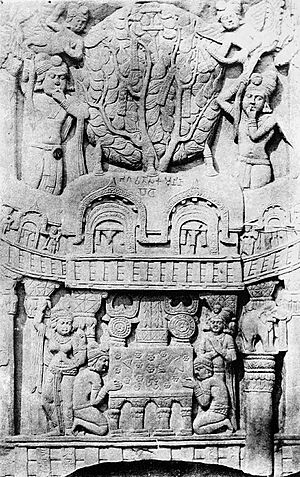
Spreading Dhamma
Ashoka's rock edicts show that he started to spread dharma (righteous living) and do good deeds for society. These activities included:
- Setting up hospitals for people and animals.
- Planting medicinal herbs.
- Digging wells and planting trees along roads for travelers.
He made sure these good deeds were done not only in his own empire but also in neighboring kingdoms. He also became closer to the Buddhist community and traveled around his empire to promote his new way of life.
Death
Ashoka died around 232 BCE, after ruling for about 37 years.
Images for kids
-
King Ashoka visits Ramagrama to get relics of the Buddha from the Nagas, but he doesn't succeed. From Sanchi.
-
An illustration of the original Mahabodhi Temple built by Ashoka at Bodh Gaya. It shows the "Enlightenment Throne of the Buddha."
-
The rediscovered Vajrasana, or "Enlightenment Throne of the Buddha," at the Mahabodhi Temple in Bodh Gaya. Ashoka built it to remember the Buddha's enlightenment.
-
Ashoka and Monk Moggaliputta-Tissa at the Third Buddhist Council.
-
The word Upāsaka (𑀉𑀧𑀸𑀲𑀓, "Buddhist lay follower") in the Brahmi script. Ashoka used this word to describe his connection to Buddhism.
-
The locations of Ashoka's Edicts and the Greek city of Ai-Khanoum.
-
The Kandahar Edict of Ashoka, a writing in both Greek and Aramaic by King Ashoka.
-
A painting from around 1910 showing Ashoka's queen in front of the Buddhist monument at Sanchi.
-
The Ashokan pillar at Lumbini, Nepal, which is Buddha's birthplace.
-
The Diamond throne at the Mahabodhi Temple, believed to be built by Ashoka.
See also
 In Spanish: Aśoka para niños
In Spanish: Aśoka para niños


